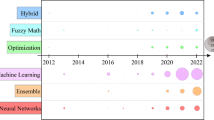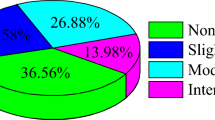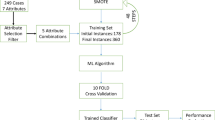Abstract
Rockburst is a major instability issue faced by underground excavation projects, which is induced by the instantaneous release of a large amount of strain energy stored in rock mass. Because of its disastrous damage to infrastructures and facilities, more and more studies have been focused on rockburst prediction. However, due to highly nonlinear relationships between the occurrence of rockburst and potential triggering factors, traditional mechanism-based prediction methods have great difficulties in providing the reliable results. In this study, a multivariate adaptive regression splines (MARS) model and a novel deep forest algorithm were applied to predict and classify rockburst intensity of a database including 344 rockburst cases collected worldwide. The t-distributed stochastic neighbor embedding method (t-SNE) was utilized for nonlinear dimensionality reduction and visualization of the original input features. After that, the Gaussian mixture model was adopted to relabel original data to determine relative intensity of these rockburst cases. Then, the MARS model and deep forest model were constructed with these newly labeled data. Their performances were compared with some widely used machine learning methods, such as random forest, extreme gradient boost, and ANN model. The results clearly proved the capability of the proposed models to assess and forecast rockburst risk. It also proved that these approaches should be used as cross-validation against each other. The Shapley additive explanations method was adopted to investigate the relative importance of input features of the developed MARS model. The result shows that σθ and σc are the most important features for rockburst intensity prediction, where σθ is the tangential stress around underground opening and σc refers to uniaxial compressive strength of the rock.



















Similar content being viewed by others
References
Aubertin M, Gill DE, Simon R (1994) On the use of the brittleness index modified (BIM) to estimate the post-peak behavior of rocks. In: Aubertin M, Gill DE, Simon R (eds) 1st North American Rock Mechanics Symposium: models and measurements challenges from industry. A.A. Balkema Austin, Texas, pp 945–952
Bai XD, Cheng WC, Ong D, Li G (2021). Evaluation of geological conditions and clogging of tunneling using machine learning. Geomech Eng (in press)
Baltz R, Hucke A (2008) Rockburst prevention in the German coal industry. In: Proceedings of the 27th international conference on ground control in mining. West Virginia University, Morgantown, WV, pp 46–50
Breiman L (2001) Random forests. Mach Learn 45:5–32
Cai W, Dou LM, Si GY, Cao AY, He J, Liu S (2016) A principal component analysis/fuzzy comprehensive evaluation model for coal burst liability assessment. Int J Rock Mech Min Sci 81:62–69
Cheng WC, Bai XD, Sheil BB, Li G, Fei W (2020) Identifying characteristics of pipejacking parameters to assess geological conditions using optimisation algorithm-based support vector machines. Tunn Undergr Space Technol 106(1):103592
Cheng WC, Li G, Liu N, Xu J, Horpibulsuk S (2020) Recent massive incidents for subway construction in soft alluvial deposits of taiwan: a review. Tunn Undergr Space Technol 96:103178.1-103178.18
Cheng WC, Ni JC, Arulrajah A, Huang HW (2018) A simple approach for characterising tunnel bore conditions based upon pipe-jacking data. Tunn Undergr Space Technol 71(1):494–504
Cheng WC, Ni JC, Huang HW, Shen JS (2019) The use of tunnelling parameters and spoil characteristics to assess soil types: a case study from alluvial deposits at a pipejacking project site. Bull Eng Geol Env 78(4):2933–2942
Cheng WC, Wang L, Xue ZF, Ni JC, Rahman MM, Arulrajah A (2019) Lubrication performance of pipejacking in soft alluvial deposits. Tunn Undergr Space Technol 91:102991
Diederichs MS (2007) Mechanistic interpretation and practical application of damage and spalling prediction criteria for deep tunnelling. Can Geotech J 44(9):1082–1116
Dietterich TG (2000) Ensemble methods in machine learning. In: International workshop on multiple classifier systems, pp1–15
Dong LJ, Li XB, Peng K (2013) Prediction of rockburst classification using random forest. Trans Nonferrous Met Soc 23(2):472–477
Du ZJ, Xu MG, Liu ZP, Wu X (2006) Laboratory integrated evaluation method for engineering wall rock rock-burst. Gold 27(11):26–30 ((in Chinese))
Faradonbeh RS, Haghshenas SS, Taheri A, Mikaeil R (2019) Application of self-organizing map and fuzzy c-mean techniques for rockburst clustering in deep underground projects. Neural Comput Appl 32:8545–8559
Faradonbeh RS, Taheri A (2019) Long-term prediction of rockburst hazard in deep underground openings using three robust data mining techniques. Eng Comput 35(2):659–675
Feng XT, Wang LN (1994) Rockburst prediction based on neural networks. Trans Nonferrous Met Soc 4(1):7–14
Feng GL, Xia GQ, Chen BR, Xiao YX, Zhou RC (2019) A method for rockburst prediction in the deep tunnels of hydropower stations based on the monitored microseismicity and an optimized probabilistic neural network model. Sustainability 11(11):3212
Friedman JH (1991) Multivariate adaptive regression splines. Ann Stat 19:1–67
Gao W (2015) Forecasting of rockbursts in deep underground engineering based on abstraction ant colonyclustering algorithm. Nat Hazards 76(3):1625–1649
Ghasemi E, Gholizadeh H, Adoko AC (2020) Evaluation of rockburst occurrence and intensity in underground structures using decision tree approach. Eng Comput 36(1):213–225
Goh ATC, Zhang RH, Wang W, Wang L, Liu H, Zhang WG (2020) Numerical study of the effects of groundwater drawdown on ground settlement for excavation in residual soils. Acta Geotech 15:1259–1272
Goh ATC, Zhang WG, Zhang YM, Xiao Y, Xiang YZ (2018) Determination of EPB tunnel-related maximum surface settlement: A Multivariate adaptive regression splines approach. Bull Eng Geol Env 77:489–500
Goh ATC, Zhang Y, Zhang R, Zhang W, Xiao Y (2017) Evaluating stability of underground entry-type excavations using multivariate adaptive regression splines and logistic regression. Tunn Undergr Space Technol 70:148–154
Hoek E, Brown ET (1980) Underground excavations in rock. The Institution of Mining and Metallurgy, London
Hotelling H (1933) Analysis of a complex of statistical variables into principal components. J Educ Psychol 24(6):417
Hucka V, Das B (1974) Brittleness determination of rocks by different methods. Int J Rock Mech Min 11:389–392
Iannacchione AT, Zelanko JC (1993) Occurrence and remediation of coal mine bumps: a historical review
Ji B, Xie F, Wang XP, He SQ, Song DZ (2020) Investigate contribution of multi-microseismic data to rockburst risk prediction using support vector machine with genetic algorithm. IEEE Access 8:58817–58828
Jia QJ, Wu L, Li B, Chen CH, Peng YX (2019) The comprehensive prediction model of rockburst tendency in tunnel based on optimized unascertained measure theory. Geotech Geol Eng 37(4):3399–3411
Jiang K, Lu J, Xia KL (2016) A novel algorithm for imbalance data classification based on genetic algorithm improved SMOTE. Arab J Sci Eng 41(8):3255–3266
Kidybinski A (1981) Bursting liability indices of coal. Int J Rock Mech Min Sci Geomech Abstr 18(4):295–304
Kwasniewski M, Szutkowski I, Wang JA (1994) Study of ability of coal from seam 510 for storing elastic energy in the aspect of assessment of hazard in Porabka–Klimontow colliery. Sci. Rept. Silesian Technical University
Li N, Feng XD, Jimenez R (2017) Predicting rock burst hazard with incomplete data using Bayesian networks. Tunn Undergr Space Technol 61:61–70
Li N, Jimenez R (2018) A logistic regression classifier for long-term probabilistic prediction of rock burst hazard. Nat Hazards 90(1):197–215
Li TZ, Li YX, Yang XL (2017) Rock burst prediction based on genetic algorithms and extreme learning machine. J Cent South Univ 24(9):2105–2113
Li TZ, Li YX, Yang XL (2017) Rock burst prediction based on genetic algorithms and extreme learning machine. J Cent S Univ 24(9):2105–2113
Liu YR, Hou SK (2019) Rockburst prediction based on particle swarm optimization and machine learning algorithm. In: International conference on information technology in geoengineering, Cham, pp 292–303
Liu R, Ye YC, Hu NY, Chen H, Wang XH (2018) Classified prediction model of rockburst using rough sets-normal cloud. Neural Comput Appl 31:1–9
Maaten LVD, Hinton G (2008) Visualizing data using t-SNE. J Mach Learn Res 9(November):2579–2605
Martin C, Kaiser P, McCreath D (1999) Hoek-Brown parameters for predicting the depth of brittle failure around tunnels. Can Geotech J 36(1):136–151
McLachlan G, Peel D (2004) Finite mixture models. Wiley
Peng Z, Wang YH, Li TJ (1996) Griffith theory and rock burst of criterion. Chinese J Rock Mech Eng 15:491–495
Pu Y, Apel DB, Pourrahimian Y, Chen J (2019) Evaluation of rockburst potential in kimberlite using fruit fly optimization algorithm and generalized regression neural networks. Arch Min Sci 64(2):279–296
Pu Y, Apel DB, Wang C, Wilson B (2018) Evaluation of burst liability in kimberlite using support vector machine. Acta Geophys 66(5):973–998
Pu Y, Apel DB, Xu H (2019) Rockburst prediction in kimberlite with unsupervised learning method and support vector classifier. Tunn Undergr Space Technol 90:12–18
Russenes BF (1974) Analysis of rock spalling for tunnels insteep valley sides. M.Sc. thesis, Norwegian Institute of Technology, Trondheim, Norway, 247 (in Norwegian)
Shapley LS (1953) A value for n-persons games. Ann Math Stud 28(7):307–318
Shi XZ, Zhou J, Dong L, Hu HY, Wang HY, Chen SR (2010) Application of unascertained measurement model to prediction of classification of rockburst intensity. Chin J Rock Mech Eng 29(1):2720–2726
Singh SP (1987) The influence of rock properties on the occurrence and control of rockbursts. Min Sci Technol 5:11–18
Steele RJ, Raftery AE (2010) Performance of Bayesian model selection criteria for Gaussian mixture models 1. Dept Stat.
Su GS, Zhang KS, Chen Z (2009) Rockburst prediction using Gaussian process machine learning. In: 2009 international conference on computational intelligence and software engineering, Wuhan, pp 1–4
Torgerson WS (1952) Multidimensional scaling: I. Theory Method Psychometrika 17(4):401–419
Wang L, Chongzhi Wu, Tang L, Zhang W, Lacasse S, Liu H, Gao L (2020) Efficient reliability analysis of earth dam slope stability using extreme gradient boosting method. Acta Geotech 15(11):3135–3150
Wang L, Wu C, Gu X, Liu H, Mei G, Zhang W (2020) Probabilistic stability analysis of earth dam slope under transient seepage using multivariate adaptive regression splines. Bull Eng Geol Environ 79(6):2763–2775
Wengang Z, Li Y, Chongzhi WU, Hongrui Li, Goh A, Zhang R (2020) Prediction of lining response for twin-tunnel construction in anisotropic clays using machine learning techniques. Undergr Space. https://doi.org/10.1016/j.undsp.2020.02.007
Wengang Z, Runhong Z, Wei W, Fan Z, Chee AGT (2019) A Multivariate Adaptive Regression Splines model for determining horizontal wall deflection envelope for braced excavations in clays. Tunn Undergr Space Technol 84:461–471
Wu SC, Wu ZG, Zhang CX (2019) Rock burst prediction probability model based on case analysis. Tunn Undergr Space Technol 93:103069
Xdb A, Wcca B, Bbs C, Ge LA (2021). Pipejacking clogging detection in soft alluvial deposits using machine learning algorithms. Tunn Undergr Space Technol (in press)
Xue YG, Bai CH, Qiu DH, Kong FM, Li ZQ (2020) Predicting rockburst with database using particle swarm optimization and extreme learning machine. Tunn Undergr Space Technol 98:103287.
Xue YG, Zhang XL, Li SC, Qiu DH, Su MX, Li LP, Li ZQ, Tao YF (2018) Analysis of factors influencing tunnel deformation in loess deposits by data mining: a deformation prediction model. Eng Geol 232:94–103
Yin X, Liu Q, Pan Y et al (2021) Strength of stacking technique of ensemble learning in rockburst prediction with imbalanced data: comparison of eight single and ensemble models. Nat Resour Res 30:1795–1815
Zhang W, Chongzhi Wu, Li Y, Wang L, Samui P (2019) Assessment of pile drivability using random forest regression and multivariate adaptive regression splines. Georisk. https://doi.org/10.1080/17499518.2019.1674340
Zhang WG, Goh ATC (2013) Multivariate adaptive regression splines for analysis of geotechnical engineering systems. Comput Geotech 48:82–95
Zhang WG, Goh ATC (2016) Multivariate adaptive regression splines and neural network models for prediction of pile drivability. Geosci Front 7:45–52
Zhang WG, Goh ATC (2016) Evaluating seismic liquefaction potential using multivariate adaptive regression splines and logistic regression. Geomech Eng 10(3):269–284
Zhang W, Li H, Li Y, Liu H, Chen Y, Ding X (2021) Application of deep learning algorithms in geotechnical engineering: a short critical review. Artif Intell Rev. https://doi.org/10.1007/s10462-021-09967-1
Zhang WG, Li HR, Wu CZ, Li YQ, Liu ZQ, Liu HL (2020) Soft computing approach for prediction of surface settlement induced by earth pressure balance shield tunneling. Undergr Space
Zhang W, Wu C, Zhong H, Li Y, Wang L (2021) Prediction of undrained shear strength using extreme gradient boosting and random forest based on Bayesian optimization. Geosci Front 12:469–477
Zhang W, Zhang R, Chongzhi Wu, Goh ATC, Lacasse S, Liu Z, Liu H (2020) State-of-the-art review of soft computing applications in underground excavations. Geosci Front 11:1095–1106
Zhang WG, Zhang YM, Goh ATC (2017) Multivariate adaptive regression splines for inverse analysis of soil and wall properties in braced excavation. Tunn Undergr Space Technol 64:24–33
Zhang W, Zhang R, Wu C et al (2020) Assessment of basal heave stability for braced excavations in anisotropic clay using extreme gradient boosting and random forest regression. Undergr Space
Zhou ZH, Feng J (2017) Deep forest: towards an alternative to deep neural networks
Zhou J, Guo H, Koopialipoor M et al (2020) Investigating the effective parameters on the risk levels of rockburst phenomena by developing a hybrid heuristic algorithm. Eng Comput 1:1–16
Zhou J, Li XB, Mitri HS (2016) Classification of rockburst in underground projects: comparison of ten supervised learning methods. J Comput Civil Eng 30(5):04016003
Zhou J, Li XB, Shi XZ (2012) Long-term prediction model of rockburst in underground openings using heuristic algorithms and support vector machines. Saf Sci 50(4):629–644
Zhou KP, Lin Y, Deng HW, Li JL, Liu CJ (2016) Prediction of rock burst classification using cloud model with entropy weight. Trans Nonferrous Metals Soc China 26(7):1995–2002
Zhou J, Shi XZ, Huang RD, Qiu XY, Chen C (2016) Feasibility of stochastic gradient boosting approach for predicting rockburst damage in burst-prone mines. Trans Nonferrous Met Soc 26(7):1938–1945
Acknowledgements
This work was supported by the National Natural Science Foundation of China (Grant No. 51778092), Natural Science Foundation (cstc2017jcyjAX0073), Chongqing.
Author information
Authors and Affiliations
Corresponding author
Additional information
Publisher's Note
Springer Nature remains neutral with regard to jurisdictional claims in published maps and institutional affiliations.
Rights and permissions
About this article
Cite this article
Guo, D., Chen, H., Tang, L. et al. Assessment of rockburst risk using multivariate adaptive regression splines and deep forest model. Acta Geotech. 17, 1183–1205 (2022). https://doi.org/10.1007/s11440-021-01299-2
Received:
Accepted:
Published:
Issue Date:
DOI: https://doi.org/10.1007/s11440-021-01299-2




